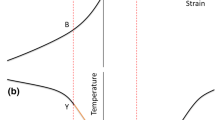Abstract
An improved calibration method for infrared radiometers is developed that has been shown to increase the accuracy of temperature measurement. To validate this new calibration technique, high strain rate compression tests are performed on the aluminum alloy BS 2011 and high strain rate torsion tests are performed on the titanium alloy 90% Ti-6%Al-4%V. The adiabatic temperature rise that occurs during these tests is measured using an infrared radiometer and validated, in the case of the compression tests, using fast response thermocouples. The proportion of plastic work converted to heat, β, is found to increase with plastic strain for both materials, which is similar to previous research. These results challenge the classical assumption that β has a constant value of approximately 0.95.
Similar content being viewed by others
References
Macdougall, D. andHarding, J., “The Measurement of Specimen Surface Temperature in High-speed Tension and Torsion Tests,”Int. J. Impact Eng.,21,473–488 (1998).
Macdougall, D. andHarding, J., “Materials Testing for Constitutive Relations,”J. de Physique, III, suppl. C3, 103–108 (1997).
Macdougall, D. andHarding, J., “A Constitutive Relation and Failure Criterion for Ti6Al4V Alloy at Impact Rates of Strain,”J. Mech. Phys. Solids,47,1157–1185 (1999).
Trojanowski, A., Macdougall, D., andHarding, J., “An Improved Technique for the Experimental Measurement of Specimen Surface Temperature During Hopkinson Bar Tests,”Meas. Sci. Tech.,9,12–19 (1998).
Hayashi, T., Yamamura, H., andOkano, S., “Temperature Measurement of Metals Under High Velocity Deformation,”Society of Materials Science, Kyoto, 94–98 (1977).
Mason, J.J., Rosakis, A.J., andRavichandran, G., “On the Strain and Strain Rate Dependence of the Fraction of Plastic Work Converted to Heat: An Experimental Study Using High Speed Infrared Detectors and the Kolsky Bar,”Mech. Mat.,17,135–145 (1994).
Xia, Y., Rao, S., andYang, B., “An Infrared Transient Temperature Measuring Apparatus and Its Application to the Tensile Impact Testing,”Exp. Mech.,5,170–176 (1990) (in Chinese).
Kapoor, R. andNemat-Nasser, S., “Determination of Temperature Rise During High Strain Rate Deformation,”Mech. Mat.,27,1–12 (1998).
Zehnder, A.T. andRosakis, A.J., “On the Temperature Distribution at the Vicinity of Dynamically Propagating Cracks in 4340 Steel,”J. Mech. Phys. Solids,39,385–415 (1991).
Hartley, K.A., Duffy, J., Hawley, R.H., “Measurement of the Temperature Profile During Shear Band Formation in Steels Deforming at High Strain Rates,”J. Mech. Phys. Solids,35,283–301 (1987).
Macdougall, D.A.S., “Materials Testing for Constitutive Relations,” Doctoral thesis, Christ Church, Oxford University (1997).
Trojanowski, A., Ruiz, C., andHarding, J., “Thermomechanical Properties of Polymers at High Rates of Strain,”J. de Physique III, suppl. C3, 447–452 (1997).
Chrysochoos, A., Maisonneuve, O., Martin, G., Caumon, H., andChezeaux, J.C., “Plastic and Dissipated Work and Stored Energy,”Nucl. Ener. Des.,114,323–333 (1989).
Rittel, D., “On the Conversion of Plastic Work to Heat During High Strain Rate Deformation of Glassy Polymers,” Technical Report No. TME 459, Technion-Israel Institute of Technology (Feb. 1998).
Taylor, G.I. andQuinney, H., “The Latent Energy Remaining in a Metal After Cold Working,”Proc. Roy. Soc. A.,143,307–326 (1933).
Hodowany, J., Ravichandran, G., Rosakis, A.J., and Rosakis, P., “On the Partition of Plastic Work into Heat and Stored Energy in Metals: Part I. Experiments,” Internal SM Report No. 98-7, California Institute of Technology (June 1998).
Dixon, P.R. andParry, D.J., “Thermal Softening Effects in Type 224 Carbon Steel,”J. de Physique III, suppl. C3, 85–92 (1991).
Zehnder, A.T., “A Model for the Heating Due to Plastic Work,”Mech. Res. Comm.,18,23–28 (1991).
Rosakis, P., Rosakis, A.J., Ravichandran, G., and Hodowany, J., “On the Partition of Plastic Work into Heat and Stored Energy in Metals: Part II. Theory,” Internal SM Report No. 98-8, California Institute of Technology (June 1998).
MODRAN Version 3.7, U.S. Air Force.
Rittel, D., “Transient Temperature Measurement Using Embedded Thermocouples,” EXPERIMENTAL MECHANICS,38,73–78 (1998).
Author information
Authors and Affiliations
Rights and permissions
About this article
Cite this article
Macdougall, D. Determination of the plastic work converted to heat using radiometry. Experimental Mechanics 40, 298–306 (2000). https://doi.org/10.1007/BF02327503
Received:
Revised:
Issue Date:
DOI: https://doi.org/10.1007/BF02327503




